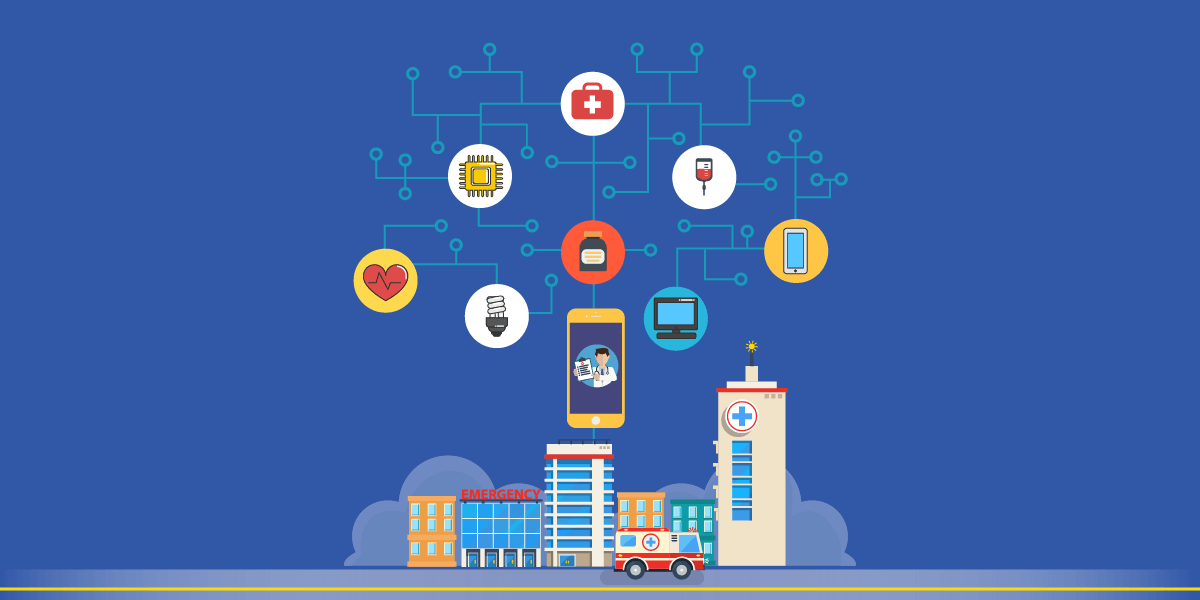Understanding the impact of IoT in healthcare
IoT in healthcare has more benefits than one can imagine.
The application of IoT in healthcare can improve the way things work in the medical world. From improved machine control to virtual medical assistance, IoT use cases in healthcare is the future. It can save the lives of patients with a fast diagnosis of diseases as well as finding an apt cure for it.
The application of the technology has become so far-fetched that there is hardly a question on What is IoT or how it works.
Like every new piece of technology, it has both advantages and disadvantages associated with it. IoT in healthcare has its own challenges and limitations which can impede the usage of the technology. But going by the joint advancement efforts of skilled IoT app development company and healthcare application development company, it can be ensured that we are reaching a time when the solution will remain safe.
Where Does IoT Fit in Healthcare?
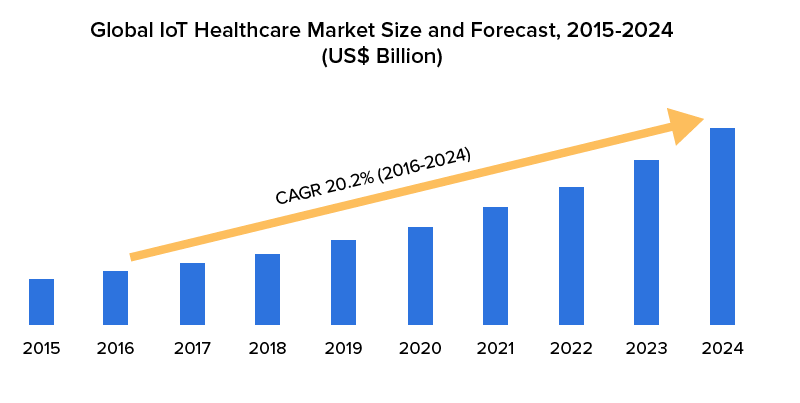
A lot of times it happens that patients don’t get medical attention on time which can harm their health severely. The delay is caused due to many reasons- unavailable rooms in the hospital, traffic on the road, unavailability of extra doctors, delay in the identification of diseases, etc.
Most of the time, people have no idea that they are suffering from an illness. To identify any signs, a visit to the doctor is required. If heart rate checkups, blood pressure level, sugar level, etc. are regularly monitored then patients can be alarmed about any upcoming threats to their health.
Also, sometimes going to the doctor for something as simple as a stomach ache and paying a heavy fee is just not worth it. These could be easily solved if there was a way to connect doctors and patients virtually.
Internet of Medical Things (IoMT) is a network of connected devices that collect data in real-time. Internet of Medical Things is one of the key applications of IoT in healthcare, impacting the industry in a positive way and has the potential to solve medical issues. According to the IoT trends 2021, the IoT in healthcare market size was $22.5 billion in 2016 and is expected to reach $72.02 billion in the year 2021. It will provide personalized care and individual data-driven medical solutions.
Not only will IoMT be able to prevent any upcoming diseases but also will be able to cure the ones that have already been caused. The technology has been made as wearables so that patients can be monitored easily without visiting the doctor.
The Internet of Medical Things has divided segments for each medical issue being faced by the healthcare industry. The on-body segment focuses on customer health wearables and other medical-grade wearables. Some products used in this segment are Fitbit, Samsung medical, etc.
The in-home segment aims at an individual’s personal health tracker solutions. This segment includes personal emergency response systems (PERS), telehealth virtual visits, and remote patient monitoring (RPM).
The community segment consists of five components: Kiosks that dispense products and provide services, mobility services to patients’ vehicles, emergency response intelligence, point-of-care devices that act like medical camps, and logistics that keep a record of all the medical equipment and goods.
Another segment is the in-clinic segment. This segment includes IoMT devices that can be used inside a clinic to provide services. The medical solutions of the in-clinic segment also provide point-of-care devices.
The last segment of IoMT is the in-hospital segment which includes various solutions for several areas of management. Asset management monitors, personnel management, patient flow management, inventory management, and environment and energy monitoring are some of the devices in this segment.
If we look at the role of IoT in healthcare sector at a stakeholder level, we can see the technology making an industry-wide impact.
For patients
Wearable devices like glucometer, heart rate cuffs, fitness bands, etc. give patients access to personalized attention. The constant tracking ability that these devices offer can have a major impact on people who live alone as it can send alerts to their family members.
For physicians
Through the mode of wearable and home monitoring devices embedded with IoT technology, physicians are able to track patients’ health a lot more effectively. The data gathered from the IoT devices can help doctors identify the best treatment and monitoring process for patients.
For hospitals
In hospitals, IoT devices embedded with sensors can be used for tracking the real-time location of medical enablers and equipment such as defibrillators, wheelchairs, oxygen pumps, nebulizers, and other similar monitoring devices. In addition to equipment, it also enables the analysis of the deployment of the medical staff at multiple locations.
These devices can also help with asset management such as environmental monitoring and pharmacy inventory control, for example, refrigerator temperature and humidity control.
Through its multi-stakeholder involvement, IoT solves a number of pain points that are prevalent in a healthcare ecosystem.
- Inefficient patient care
- Medical process mistakes
- Supply chain management
- Medical research
- Rural healthcare management
What are The Benefits of IoT in Healthcare?
IoT in healthcare is helping the way hospitals attend to the patients. While the rapid population growth is not helping to control the increased illness, old age, and other health issues, the introduction of IoT in healthcare may do it. IoT can also reduce the cost of medical treatment to a great low. The following are a few of the most noteworthy advantages of the Internet of Things:
Simultaneous reporting and monitoring
IoT in the healthcare industry has enabled doctors to monitor the real-time conditions of a patient which can prevent any emergency situations like heart failure, diabetes, asthma attack, cardiac arrest, etc. The impact of IoT in healthcare has made it easy for doctors to attend to multiple patients in a matter of minutes.
The medical reports of patients including blood sugar levels, ECG reports, X-rays, etc. are stored in the cloud and can be accessed with a mobile device whenever needed.
End-to-end connectivity and affordability
The Internet of things in healthcare applications can allow a better connection and use of the latest technology to enhance connectivity and data sharing. With technologies like Bluetooth, Wi-Fi, and other features, tracking and identifying illness becomes easy and less time-consuming.
This also reduces the overall time and cost of treatment. With technology, the cost of treatment will reduce by a huge sum, allowing patients to be treated easily.
Data analysis and data assortment
The use of IoT in healthcare involves storing massive data about the patient’s medical history. The IoT device also has to send data to other devices without any issues occurring in the process. Manually analyzing such huge data is impossible but devices can do it.
IoT devices can gather, analyze, track, send and receive data with the help of a cloud base. The cloud base is required as the size of data is huge and cannot be saved on the server. What can help make this adoption further and make it more efficient in terms of data storage and transfer is the Blockchain of Things.
Real-time tracking and alerts
Imagine how many lives can be saved with emergency alerts sent by patients. The Internet of Medical Things has made this possible. With the help of a device, a patient’s medical information is recorded in real-time and can be sent to the doctor. In the case of any threat, the doctor will be informed immediately and can provide assistance accordingly.
Check-up on the go
With the help of IoT healthcare devices, patients can easily contact doctors on their mobile devices and get immediate assistance. With the latest IoT devices, doctors can identify any ailments on the go all the while saving travel costs and time. IoT in healthcare will also be able to dispense medicines from machines as per their prescription. This will be done by connecting the patient’s device with the medicine dispensing machine.
IoT Use Cases in Healthcare
The Internet of things healthcare is being used for some great work in the healthcare industry. From monitoring the patients to virtually assisting them, applications of the Internet of Things are immensely vast and diverse. Here are some of the use cases of IoT technology in healthcare:
Remote patient monitoring
It is one of the most common use cases of the technology in healthcare that an IoT mobile app development company works around. The applications are built to collect health vitals like blood pressure, heart rate, temperature, etc from the patients that are not physically present in the healthcare facility. The algorithms can then help analyze the vitals and recommend treatment or simply create an alert.
Reducing wait time
Often a patient’s condition gets worse while waiting for things to be arranged or rooms to clear out in a hospital. With IoT in the healthcare industry, the waiting time can be reduced by more than 50%. When it comes to occupancy, IoT can track all the rooms and find the empty ones for the incoming patients who need immediate assistance.
Keep track of hardware maintenance
Every hospital has devices, machines, and equipment that are used to sustain human lives. Availability of these tools is necessary in order to save as many lives as possible. With IoT technology, hospitals can not only track the types of equipment but also be informed when a piece of equipment is about to fail. This helps the hospital in getting new devices before it’s too late.
Tracking employees and patients
A hospital has huge buildings and it becomes impossible to track where each and every employee or doctor is at a particular moment. It is the same for all the patients as well. With IoT technology, tracking the patients and the staff is easy.
This technology is also being used to track the assets of the hospital for security reasons. It is a highly efficient technology to track objects or people without any additional cost or efforts.
Drug management
Medicines are now being monitored by IoT devices to ensure the proper dosage and tracking of the effects of the medicine. It can also remind patients to take their medicine on time and in the right amount. If there is an overdose or underdose of medicine then the patient will be alerted.
Identification of chronic diseases
The Internet of things healthcare technology identifies any chronic illness a patient is suffering from. How that works is: a patient enters his symptoms and the device matches it with the already existing information to identify the disease.
Wearable devices like Fitbit are great trackers of heart rate, sugar levels, and blood pressure levels. Healthcare app development solutions for wearables and mobile apps have made people more health-conscious and aware of their medical conditions.
A few examples of the Internet of Things applications in healthcare

Healthcare IoT devices are specimens of technical brilliance. These come in handy with loads of benefits of IoT like minimizing the waiting time for emergency rooms, patient, staff, and inventory tracking, discipline in drug management, and checking that critical hardware is available at all times.
Hearables
The hearing aid has been around for ages thanks to the genius of Miller Reese Hutchison. With time, these devices underwent massive changes and are the ones currently powered by IoT have transformed the manner of interaction for people with hearing loss. These hearables are synced with smartphones via Bluetooth. Sounds can be filtered, equalized, and tailored to create real-world sound.
Moodables

Stress can often cause declining mental health and there are times when patients with mental disorders or neurovascular problems need to uplift their moods. They are wearables mounted on the head that pass low-intensity currents to the brain. These electrical impulses help to alleviate the pain and lighten up the mind.
Smart pills
Smart pills are edible IoT pills that are used to monitor our body functioning and alert if any anomaly arises. They have micro-sensors that are ingestible and dissolve in the stomach. The body too is attached to a device that accumulates the data transmitted via the sensors. One can easily access the data through their smartphones. This is one of the IoT advantages which proves how powerful the technology is.
Healthcare charting
Patient charting by doctors requires a lot of time and effort. It’s a fascinating thing to know how IoT is implemented and through voice commands, doctors can summon a patient’s vital clinical information like medical history, demographics, diagnoses, medications, treatment plans, progress notes, immunization plans and schemes, allergies, tests (X-Ray, cardiology, radiology, urine, blood, etc.) and the results. Augmedix is one such device that does that.
Computer vision technology
A major development of IoT in healthcare projects is the drones which have proven to replicate visual perceptions ergo influencing decision making. These drones are powered by AI and have been known visually impaired people to alert about obstacles and avoid them.
Challenges Faced in IoT Based Healthcare System
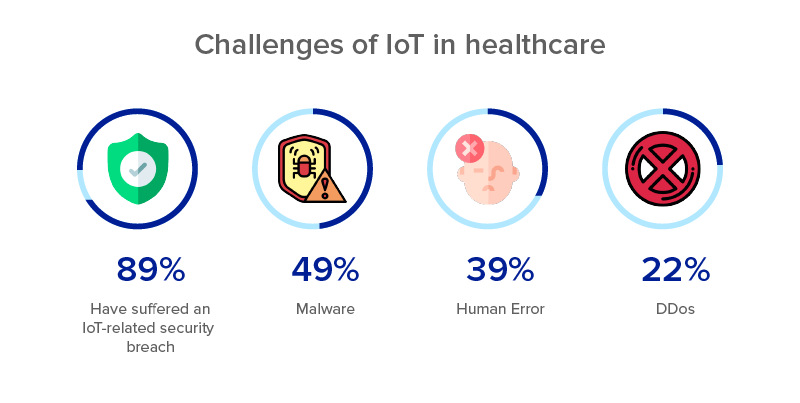
Even though IoT is being helpful in the healthcare industry, it has its limitations and challenges. Let us look at the adoption challenges of IoT in healthcare:
Privacy and security
Though the IoT benefits in healthcare are many yet we cannot ignore the challenges it is facing. The biggest threat to healthcare in IoT is data privacy and security. The massive data that is being transferred and stored on a regular basis can be hacked and used against the patient and the doctor.
Hackers can create fake IDs to buy drugs and medicines only to misuse them further. A solution to this pestering issue, however, lies in following the compliance set up by the government for healthcare application development USA.
Multiple devices and protocol integration
Everyone owns a different device and this difference in devices is causing problems with the performance of the technology. The internet of medical things has yet to find a solution regarding the compatibility of different devices with the IoT network. The connectivity of different devices slows down the entire process of data transfer, analysis, and retrieval.
Overloading and inaccuracy
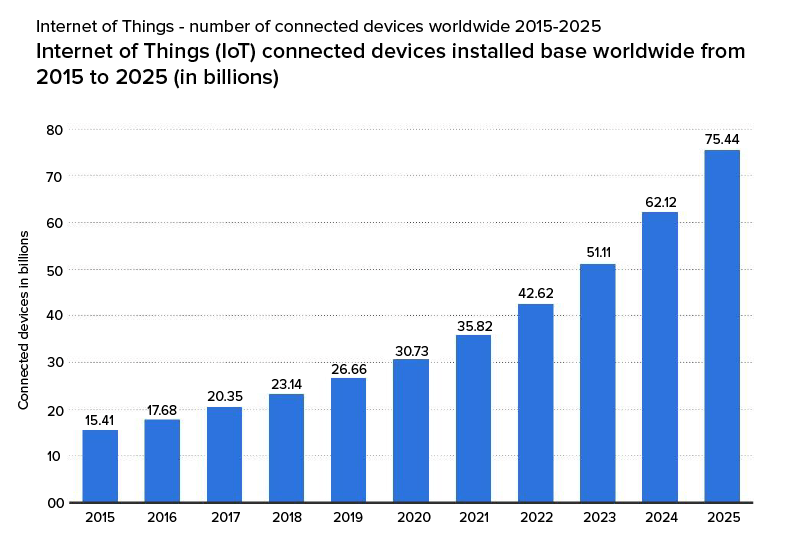
Storing patient data means storing an impossible amount of data. Even with the internet of healthy things, the huge amount of data is becoming difficult to manage by the doctors. If this continues then the decision-making will be affected putting many lives in danger all at once. The more devices being connected to the network, the more will be the inflow of data.
Cost of the technology
It must be a surprise to see IoT cost in the challenges section. But the truth is IoT can reduce the treatment cost for a common man but hasn’t been able to do it yet. The Internet of things and healthcare have yet to make things cost-effective and it will take time. It has created the medical tourism situation where people travel to developing countries to get the treatment at a much cheaper cost. The cost of IoT app development is also higher than the usual cost of mobile app development.
The Future Scope of IoT in Healthcare
IoT has a lot of potentials and it’s not only in healthcare. Many IoT healthcare companies are working on new ways to use this technology to help our medical world. According to the IoT healthcare market trends, the industry is expected to grow to $8.9 trillion in the year 2020.
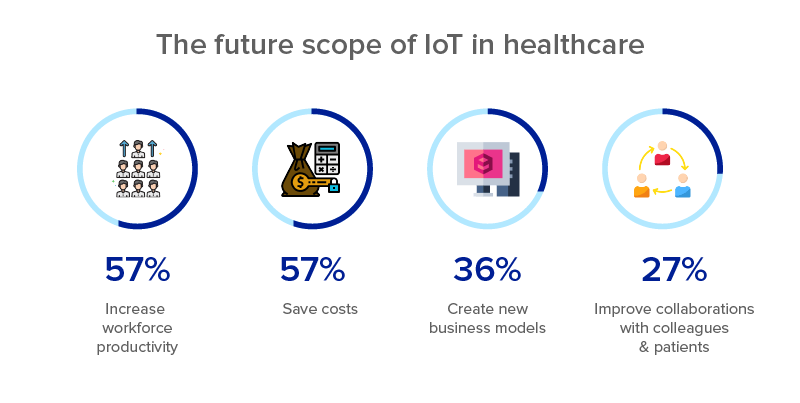
Even though IoT has challenges and limitations, it will not stop the technology from growing. The need for IoT in healthcare is huge and it can help the industry immensely. It can reach every patient from all over the world and connect doctors with patients. There is no denying that IoT has already made a huge impact and is only set to grow further.
It is a matter of time when the medical industry will be run mostly by IoT technology and will be treating patients in less time and low cost of treatment. Google and Apple are companies trying to make IoT and healthcare success and soon we shall see iOS and Android devices interacting with our medicines.
We at Appinventiv have IoT app developers in New York and India that are ready to help you with your app idea. We have a proven track record for making IoT real-time applications. Contact us today!
FAQs
Q) How is IoT used in healthcare?
There are many applications of the Internet of Things that can be used by people for their benefit. Patients, doctors, medical staff, families, insurance companies can use them to track important data and updates that are important for the concerned person(s). It makes healthcare professionals more keen-eyed about the patients so that no negligence occurs.
Q) What effect will the Internet of Things (IoT) have in healthcare?
With state-of-the-art healthcare mobility solutions, IoT enhances the patient care process in many ways like-
- Real-time Monitoring
- IoT Smart Pills
- Controlling Diabetes
- Smartwatches to cure Major Depressive Disorder (MDD)
- Monitoring of blood pressure
Q) What is smart technology in healthcare?
Smart technology or smart healthcare conforms to modern technology methodology of improving the patient workflow. The technology uses wearable devices with the IoT technology that can access copious information with automated responses and also catalyze the communication between to concerning parties (which include people or institutions). With more accuracy and speed, the healthcare ecosystem has truly benefited from this technology.
Q) Why is IoT important in healthcare?
With healthcare progressing rapidly with the help of technology, IoT adds important value to it.
The Internet of Things in healthcare makes it convenient for patients to be watched and monitored carefully and come up with preventive measures. The data collected through devices/wearables help in prognosis and diagnosis by a medical expert.
Q) What are the benefits of using IoT?
IoT is one of the most sought-after technologies at present. Every field, every industry is looking for the best IoT solutions to augment its growth opportunities. It has many advantages like
- Increasing the scope of communication
- Collecting huge amounts of data
- Generating automated responses
- Monitoring activities and habits
- Saving precious time and money
- Improving the quality of life

strategies your digital product..
